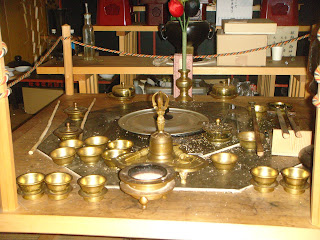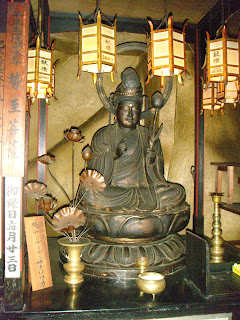On August 20th,
I visited Ryōzen Kannon 霊山観音 in Kyōto. This enormous statue that measures 24m was
erected after World War II to commemorate the people who died in battle.
A miniature
version of the statue inside where one can make offerings of money and
incense.
Note the Shinto
style rope (shimenawa 注連縄)
Three ihai 位牌 (spirit tablets) for
水子の靈 the spirits of children who were aborted, born dead or
died soon after birth.
殉国英靈the spirits of the people who died for
their country
三界萬靈 the spirits of the three worlds
Statue
of a Buddha, presumably the historical Buddha Shaka-nyorai 釈迦如来.
A
sculpture of a snake near an altar for Benzai-ten 弁財天, who is often associated with Uga-jin 宇賀神 (often depicted as a snake with a human head).
The
objects used for religious worship look very esoteric, but I could not confirm
any association with Shingon Buddhism or Tendai Buddhism.
A
hidden Benzai-ten statue to the right of the main idol.
The
eleven-headed Kannon 十一面観音 is this
temple’s honzon (本尊, “main idol”).
A
statue of Jizō-bosatsu 地蔵菩薩 to the left of the main idol.
A notice that
informs visitors about the monthly Dai-goma
kuyō 大護摩供養 (burning of cedar sticks that
have wishes written on them, often asking for protection in traffic, study or
work).
A
statue of the historical Buddha as he dies and enters Nirvāṇa (Skt: निर्वाण).
In the
restroom I found an image of Ususama-myōō 烏枢沙摩明王, the guardian of bathrooms, right
above the mirror.
A box where
visitors can deposit old lucky charms etc.
Mizuko Jizō
Upstairs I
found a number of beautiful statues, somewhat hidden in the dark. There was a
piece of wood next to each one of them, indicating the Shingon 真言 (“True word”: incantation; mantra) of the deity.
Sen-ju Kannon 千手観音, “The thousand-armed Kannon”
Kokū-bosatsu 虚空菩薩
Yakushi-nyorai 薬師如来
A box containing a
statue of Shō Kannon-bosatsu 聖観音菩薩
Monju-bosatsu 文殊菩薩
Seishi-bosatsu 勢至菩薩
Dainichi-nyorai 大日如来
Fudō-myōō 不動明王
Amida-nyorai 阿弥陀如来
Daikoku-ten 大黒天
Two more Kannon
statues in another building
The inside of a
building where ihai are kept.



























































